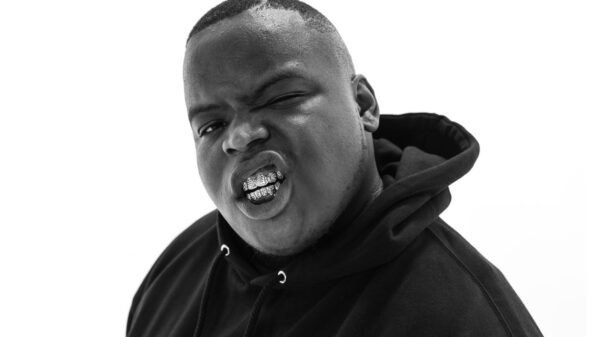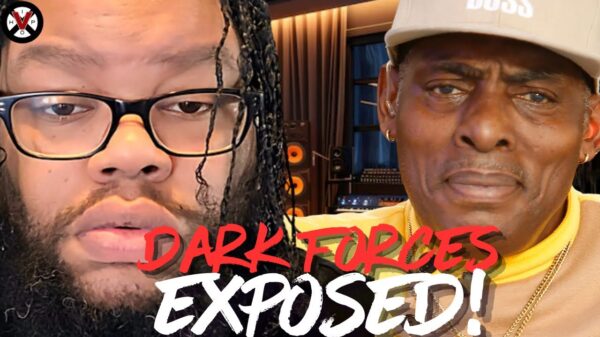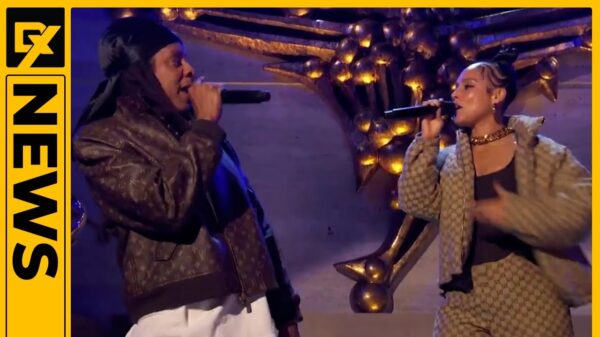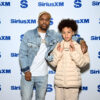This article has been handpicked from the Okayplayer editorial archives and included in our Hip Hop 50 collection as a noteworthy inclusion to the genre’s rich and diverse narrative. The article has been edited for context to ensure its accuracy and relevance.
It’s become a cliche to state that fashion is cyclical — trends from the past always return 15 or 20 years after their initial popularity. In the case of hip-hop fashion, the difference between the cyclical nature of trends is more complicated. Fashion is not only related to the five pillars of hip-hop (emceeing, breakdancing, DJing, graffiti, and knowledge), but it is a testament to the enduring cultural language of the genre. As in, there is a shared sartorial legacy that draws on hip-hop’s ability to bring together streetwear, high fashion, DIY design, African heritage, and its revolutionary and radical roots. This is why trends from the ‘80s remain foundational across generations, and hip-hop remains forward-thinking — because a remix doesn’t just refer to a different version of a song.
During formative decades of hip-hop, each region began developing its own style, but it was always functional and funky. For example, in her book, Free Stylin’: How Hip Hop Changed the Fashion Industry, Elena Romeronoted how b-boys tapered their track pants and jeans for easy dancing. West Coast rappers were mutually inspired by the lowrider culture of Chicanos, adopting the ease of khaki pants, white vests, and plaid button ups. Though Southern hip-hop burst into national consciousness toward the end of the ‘90s and early ‘00s, the sexy, country, afrofuturistic, and larger-than-life elements of New Orleans, Houston, and Atlanta were present in the style of Outkast, UGK, No Limit and more.
The most important element of hip-hop fashion that endures today is race pride. Each style, trend, and fad emerged from Black creators and musicians, all of them pointing to the specifics of beauty, culture, and heritage reflected in the Black is Beautiful Movement from the ‘70s, which preached self-acceptance, love, diversity of skin tones, and Afrocentric colors. As the U.S. government’s War on Drugs affected the Black community, the relationship of hip-hop and style was unerringly rooted in a form of self-determination that promoted continuing to love Black culture in a world that often didn’t love it — or the community — back. The presence of ‘80s hip-hop fashion going into the 2020s continues to reflect that deliberate call to consciousness, highlighting why hip-hop is a foundational genre for Black expression. These are the ‘80s hip-hop fashion trends that continue to be present to this day.
Denim
Portrait of the members of American hip hop group Funky 4 + 1, 1980.
Photo by Anthony Barboza/Getty Images
Prior to the ‘70s, denim was mostly worn by sharecroppers and factory workers. Student organizations like SNCC, and later radical youth movements like the Black Panther Party, wore denim to show solidarity with working class and rural Black folks. By the ‘80s, denim had become a status symbol, with an explosion of brands catering to consumers who couldn’t get enough of acid wash, black, indigo, bell bottoms, tapered, and more. It was common for young people to put their own spin on their denim, but hip-hop culture took it a step further: oversized jackets, patches with Black power fists or slogans, and cuffing the hems. There was the ‘90s and ‘00s interlude with wide, baggy jeans. But today’s skinny jeans and the return of straight leg and tapered jeans wouldn’t look so unusual to hip-hop heads in the ‘80s.
Afrocentric colors and prints
Rapper Queen Latifah (Dana Elaine Owens) poses for photos backstage at Mosque Maryum in Chicago, Illinois in June 1989.
Photo By Raymond Boyd/Getty Images
Part of the consciousness-raising element of hip-hop was urging a return to African roots and aesthetics. The Pan-African flag, created by Marcus Garvey in the 1920s, and kente cloth became a motif in the color schemes and prints of t-shirts, jackets, hats, and accessories. Furthermore, the anti-apartheid movement of the ‘80s strengthened Africa’s influence on hip-hop, where an artist like Afrika Bambaataa explicitly made a connection between the continent and hip-hop. Today’s Buy Black movement, as well as the emergence of Juneteenth as a national holiday, is reflected in the more subtle touches of an African aesthetic — from the brightly colored clothes of Christopher John Rogers to the resurgence of Dapper Dan and his collaboration with Gucci (whose primary color scheme of green, red, and gold are very similar to Pan-African colors).
Logos
American hip hop musician and rapper Roxanne Shante, wearing an outfit by Dapper Dan, circa 1989.
Photo by Michael Ochs Archives/Getty Images
Speaking of Dapper Dan, the most enduring trend that bridges the ‘80s and today is the logo print. As the supreme remixer of fashion, Daniel Day transformed luxury fashion into the streetwear giant it remains today. He coined the phrase “logomania” to refer to the explosion of popularity of the interlocking C’s (Chanel), G’s (Gucci), LV’s (Louis Vuitton), and H’s (Hermes) on his custom made clothes. Hip-hop stars and wannabes viewed the logo as a status symbol for cool and luxury, and Dapper Dan’s aesthetic turned designer clothing into the dominant visual culture of hip-hop. Despite the demands for “quiet luxury” that dominate discussions of contemporary fashion, logomania continues to be where street meets luxe, pushing the creativity of high fashion designers eager to capture the forward-thinking fashion culture of hip-hop.
Athleisure
LL COOL J Performing Live At Hanover Nightclub, London 01/01/1985
Sony Music Archive via Getty Images/Terry Lott
The term was coined in the late ‘70s and became ubiquitous in the 2010s and 2020s to describe the dominance of athletic wear as part of the daily style of contemporary Americans. The word conjures the image of yoga pants and neutral colored leotards, but this erases the fact that hip-hop has historically driven the trend for athletic wear as everyday style. From LL COOL J’s track suits and customized Shirt Kings sweatshirts to hoodies and sweatpants, the mix of cool swag and comfort was pioneered by hip-hop artists. They elevated basics that were worn in the gym or at home by buying them in bright colors, pairing them with sneakers, embellishing them with gold jewelry, and styling them with a b-boy sensibility.
Big hoop earrings
Rapper MC Lyte appears in a portrait taken on May 5, 1989 in New York City.
Photo by Al Pereira/Getty Images/Michael Ochs Archives
Women in hip-hop toed the line between the necessary bombast of the genre and their femininity. When Black women in the ‘80s like Roxanne Shanté, J.J. Fad, and MC Lyte donned huge gold hoops, bamboo hoops, and doorknockers, they were staking a claim as being a woman and being hip-hop. The hoop earring was to Black women what the heavy gold chain was to Black men in the genre. Earring trends change on a regular basis, but the hoop earring remains a sign of defiance, cool, and brash femininity.
Sneakers
Joseph ‘Run’ Simmons and Darryl ‘D.M.C.’ McDaniels perform on stage during the Together Forever Tour on July 29, 1987 at the Pine Knob Music Theater in Clarkston, Michigan.
Photo by Ross Marino/Getty Images
When Run D.M.C. released their 1986 song “My Adidas,” it was both an ode to the preeminent shoe of hip-hop, and to hip-hop being here to stay (it was written in response to an anti-rap song that called the group’s Adidas Superstars, “felon sneakers”). Other brands like Converse, Reebok Classics, New Balance, and Nike vied with Adidas for popularity, and were sometimes tied to regional trends (New Balance was a symbol of Washington D.C.’s hip-hop culture, for example). The athleisure and streetwear trend of the 2010s was accelerated by the pandemic, and now it is not unusual for someone to pair a nice suit with a clean pair of Adidas Superstars.
Braids
American hip hop musician and rapper Roxanne Shante, UK, 14th March, 1989.
Photo by David Corio/Redferns
The braid — cornrow, kanekalon, singed ends, beaded, curled, blonde, black, and every color of the rainbow — continues to be a focus of hip-hop culture and femininity. It is an enduring trend that has outlasted the afro, the jheri curl, the Halle Berry pixie, and the blunt layered extensions of the ‘80s, ‘90s, and ‘00s. For Black girls and women, braids are both a form of creative expression and a link to the African heritage that hip-hop culture prides. Also enduring is their unexpected controversy, particularly in the workforce, where Black hair continues to be viewed as “unprofessional.” Yet, just like hip-hop demanded in the ‘80s, Black aesthetics are about racial pride and a counter-narrative to what is “professional” or “respectable.” Black girls and women today continue to play with the many colors and styles that braids give, contesting the idea of fitting into mainstream society.
—
Angela Tate is a writer, museum worker, and creative whose work focuses on women of the African Diaspora, Black feminism, style, wellness, technology, and the arts. Her work has been published in a variety of journals and online outlets, but she’s most proud of her historical fiction. You can learn more at www.atpublichistory.com
Read the full article here









































